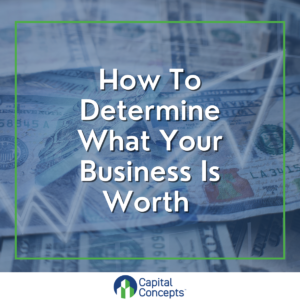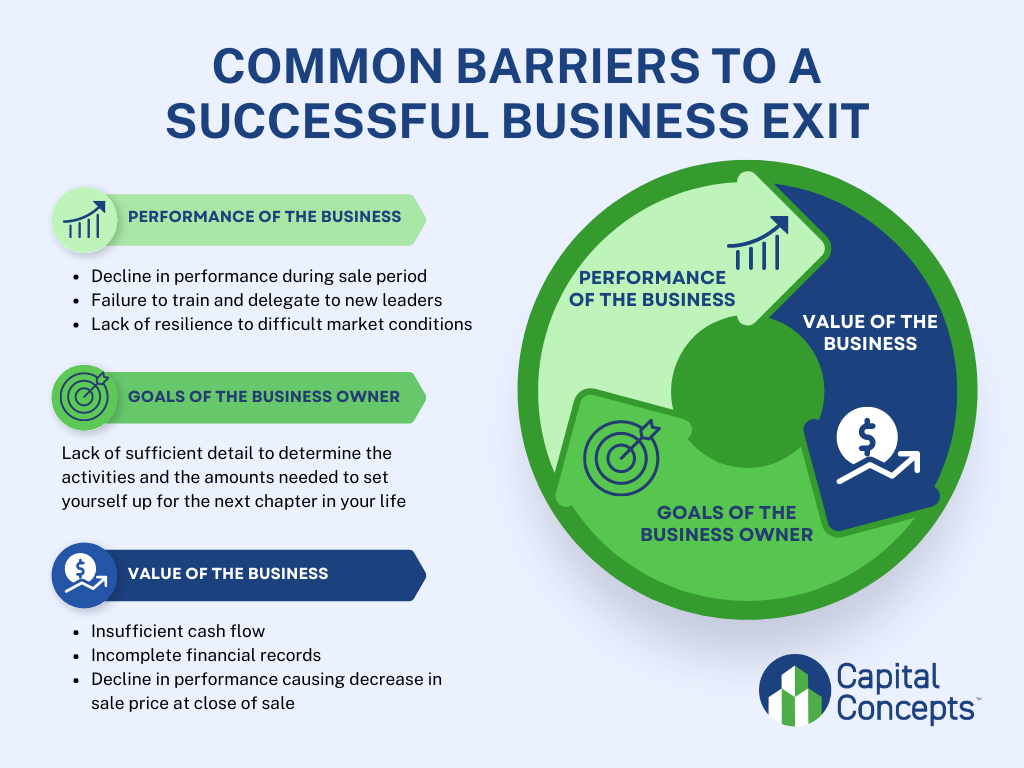Defining your retirement goals does more than help you fill the days no longer consumed by your business. It also allows you to prepare your personal financial plan. What will your expenses be, and how much do you need out of the business to cover those? Returning to work later because you’re running out of money is avoidable if you plan well up front, make proper investments along the way, and, if you need to sell the business as part of your exit, get the sale price you need.
Common Barrier 2: The Value of the Business

As mentioned in our first article, while only 20% of businesses actually sell, just under 3% of businesses sold actually achieve the desired sale price. With that desired sale price (or the value you need from this asset) determined, the next common barriers to overcome are determining the value of the business and then maintaining that value through the exit process.
Most people would be shocked at how many companies operate without balancing their books each month and how many are just one unpaid invoice away from being unable to make payroll. While common, you must clean up and maintain your financial documentation or you will be unable to steer the business effectively or monitor the key metrics needed to determine the value you have in your business.
Managing cash flow is often a challenge, especially if your business has government clients or others with extremely long payment terms. It can also be impossible to invest in improvements or expand without additional capital. If you work with good advisors, you will find a surprising number of options for improving cash flow.
Finally, many owners face an unpleasant surprise at the closing of their business sale – a decline in the value of their business that lowers the final sale price. Many factors can cause the value of a business to slide during the sale or exit process, but it ultimately means the business’s performance dropped.
Common Barrier 3: The Performance of the Business
If an owner has failed to sufficiently prepare new leaders to take over the company, this will appear as soon as the owner shifts their focus from operations to his or her exit. When the business’s success depends too much on the owner, its performance (and thus its value) will decline when the owner steps away.
Owners must delegate their responsibilities to others, both to ensure the performance remains strong when they leave and to give themselves the bandwidth to plan and execute their exit. Consistent results in a business require a commitment to identifying repeatable processes, documenting them, implementing systems, and training new leaders to manage it all.
Another critical performance issue is resilience in the face of unpredictable markets. Diverse revenue streams, or making sure your customers are not all concentrated in one area, will help your business become shock-resistant and continue to deliver even when others are struggling.
Conclusion
We will dive more deeply into each of these common barriers over the coming weeks. We’re also interested in hearing from you. What are the biggest hurdles you are facing? How have you seen overcoming one of these common barriers transform your own company? Send us InMail or email Clientsuccess@CapConceptsUSA.com to share with us. We just might feature you in a future article.
[/et_pb_text]Related Articles
Get A Grip Roundtable
Does This Sound Familiar? Your business isn't as efficient or profitable as you'd like. You’re putting in the hours but not seeing the results you want. You’re stuck. You know your business has potential, but you're unsure how to take it to the next level. You’re...
Eight Ways to Exit Your Business
When it comes to exiting a business, most people assume there is only one way out: sale. But actually, there are 8 distinct ways to exit a business. Before considering your next move, it’s crucial that you understand each of these options to determine which is best...
The Formula for an Effective Exit Plan
Ask a business owner over the age of 50 when they plan to transition or exit their business, and you’ll get one of two answers:
– a blank stare, or
– “I’ll work another 5-10 years and call it quits.”(And if you ask this person again in another 5-10 years, you’ll likely get the same answer!)
The bottom line is the same – most business owners lack a plan for leaving their business. Read the article to learn what goes into an exit plan.
Last week, we wrote about how important exit planning is, whether your business is struggling or thriving. (If you missed it, check out the first article in our series on Exit Planning.) This week, before we begin our deep dive into successful exit planning, we pause to look at the bigger picture. A successful exit will require you to overcome multiple barriers, all of which are interconnected. The good news is we know what the most common barriers are, and by doing this work, you will also build a stronger business.
For example, before you can get a valuation of your business, you need all of your financials in order. This is the moment many business owners discover their bookkeeping is a mess! As they begin cleaning it up, they often uncover performance issues like inconsistent sales or unpaid invoices, all of which affect both the performance and valuation of the business. Bringing in the right people for the work will improve efficiency and make it easier to delegate, but it may also uncover a lack of documented processes. All of this works together to strengthen the business and make it more profitable.

Common Barrier 1: The Goals of the Business Owner
One of the more surprising issues business owners face is not knowing what they want to do when they no longer own their business. They must set goals in sufficient detail to determine the activities and the amounts needed to set themselves up for the next chapter in their life.
Adjusting to a new life and rhythm can be more difficult than it sounds at first. Many of us start businesses because we love the challenge. We pour ourselves into them, which means that we often do not develop additional interests outside of our careers.
Before you can successfully exit your business, you need a plan for what’s next. Trust me – you will tire of golf every day after a few months. Ask yourself questions like these:
- Will you travel?
- Will you have a second home for part of the year?
- What hobbies will you pursue?
- Do you need to learn something (e.g. a foreign language, maintenance of a sailboat) for the next chapter?
- What kind of charitable or community pursuits interest you?
Defining your retirement goals does more than help you fill the days no longer consumed by your business. It also allows you to prepare your personal financial plan. What will your expenses be, and how much do you need out of the business to cover those? Returning to work later because you’re running out of money is avoidable if you plan well up front, make proper investments along the way, and, if you need to sell the business as part of your exit, get the sale price you need.
Common Barrier 2: The Value of the Business

As mentioned in our first article, while only 20% of businesses actually sell, just under 3% of businesses sold actually achieve the desired sale price. With that desired sale price (or the value you need from this asset) determined, the next common barriers to overcome are determining the value of the business and then maintaining that value through the exit process.
Most people would be shocked at how many companies operate without balancing their books each month and how many are just one unpaid invoice away from being unable to make payroll. While common, you must clean up and maintain your financial documentation or you will be unable to steer the business effectively or monitor the key metrics needed to determine the value you have in your business.
Managing cash flow is often a challenge, especially if your business has government clients or others with extremely long payment terms. It can also be impossible to invest in improvements or expand without additional capital. If you work with good advisors, you will find a surprising number of options for improving cash flow.
Finally, many owners face an unpleasant surprise at the closing of their business sale – a decline in the value of their business that lowers the final sale price. Many factors can cause the value of a business to slide during the sale or exit process, but it ultimately means the business’s performance dropped.
Common Barrier 3: The Performance of the Business
If an owner has failed to sufficiently prepare new leaders to take over the company, this will appear as soon as the owner shifts their focus from operations to his or her exit. When the business’s success depends too much on the owner, its performance (and thus its value) will decline when the owner steps away.
Owners must delegate their responsibilities to others, both to ensure the performance remains strong when they leave and to give themselves the bandwidth to plan and execute their exit. Consistent results in a business require a commitment to identifying repeatable processes, documenting them, implementing systems, and training new leaders to manage it all.
Another critical performance issue is resilience in the face of unpredictable markets. Diverse revenue streams, or making sure your customers are not all concentrated in one area, will help your business become shock-resistant and continue to deliver even when others are struggling.
Conclusion
We will dive more deeply into each of these common barriers over the coming weeks. We’re also interested in hearing from you. What are the biggest hurdles you are facing? How have you seen overcoming one of these common barriers transform your own company? Send us InMail or email Clientsuccess@CapConceptsUSA.com to share with us. We just might feature you in a future article.
Related Articles
Get A Grip Roundtable
Does This Sound Familiar? Your business isn't as efficient or profitable as you'd like. You’re putting in the hours but not seeing the results you want. You’re stuck. You know your business has potential, but you're unsure how to take it to the next level. You’re...
Eight Ways to Exit Your Business
When it comes to exiting a business, most people assume there is only one way out: sale. But actually, there are 8 distinct ways to exit a business. Before considering your next move, it’s crucial that you understand each of these options to determine which is best...
The Formula for an Effective Exit Plan
Ask a business owner over the age of 50 when they plan to transition or exit their business, and you’ll get one of two answers:
– a blank stare, or
– “I’ll work another 5-10 years and call it quits.”(And if you ask this person again in another 5-10 years, you’ll likely get the same answer!)
The bottom line is the same – most business owners lack a plan for leaving their business. Read the article to learn what goes into an exit plan.

